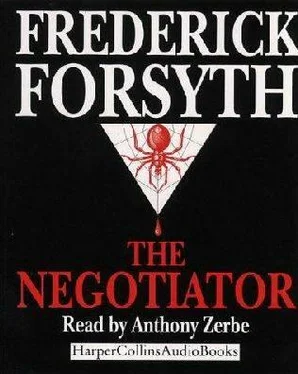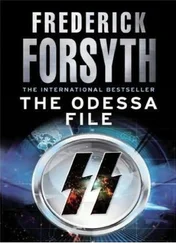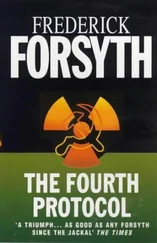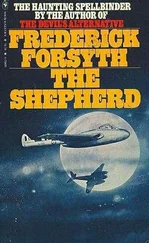Frederick Forsyth - The Negotiator
Здесь есть возможность читать онлайн «Frederick Forsyth - The Negotiator» весь текст электронной книги совершенно бесплатно (целиком полную версию без сокращений). В некоторых случаях можно слушать аудио, скачать через торрент в формате fb2 и присутствует краткое содержание. Жанр: Триллер, на английском языке. Описание произведения, (предисловие) а так же отзывы посетителей доступны на портале библиотеки ЛибКат.
- Название:The Negotiator
- Автор:
- Жанр:
- Год:неизвестен
- ISBN:нет данных
- Рейтинг книги:5 / 5. Голосов: 1
-
Избранное:Добавить в избранное
- Отзывы:
-
Ваша оценка:
- 100
- 1
- 2
- 3
- 4
- 5
The Negotiator: краткое содержание, описание и аннотация
Предлагаем к чтению аннотацию, описание, краткое содержание или предисловие (зависит от того, что написал сам автор книги «The Negotiator»). Если вы не нашли необходимую информацию о книге — напишите в комментариях, мы постараемся отыскать её.
The Negotiator — читать онлайн бесплатно полную книгу (весь текст) целиком
Ниже представлен текст книги, разбитый по страницам. Система сохранения места последней прочитанной страницы, позволяет с удобством читать онлайн бесплатно книгу «The Negotiator», без необходимости каждый раз заново искать на чём Вы остановились. Поставьте закладку, и сможете в любой момент перейти на страницу, на которой закончили чтение.
Интервал:
Закладка:
The van had had a puncture, front offside tire. A man crouched beside it with a wrench, seeking to free the wheel which was raised on a jack. He bowed over his work. The youth called Simon was on the verge across the rutted track from the van and he kept running.
As he passed the front end of the van two things happened with bewildering speed. The rear doors flew open and two men, identical in black track suits and ski masks, leaped out, hurled themselves on the startled runner, and bore him to the ground. The man with the wrench turned and straightened up. Beneath his slouch hat he, too, was masked, and the wrench was not a wrench but a Czech Skorpion submachine gun. Without a pause he opened fire and raked the windshield of the sedan sixty feet away.
The man behind the wheel died instantly, hit in the face. The car swerved and stalled as he died. The man in the backseat reacted like a cat, opening his door, bailing out, rolling twice, and coming up in the “fire” position. He got off two shots with his short-nosed Smith & Wesson 9mm. The first was wide by a foot, the second ten feet short, for as he fired it the continuing burst from the Skorpion hit him in the chest. He never stood a chance.
The man in the passenger seat got free of the car a second after the man in the back. The passenger door was wide open and he was trying to fire through the open window at the machine gunner when three slugs punched straight through the fabric and hit him in the stomach, bowling him backwards. In five more seconds the gunman was back beside the driver of the van; the other two had hurled the student into the rear of the Transit and slammed the doors, the van had rolled off its jack, done a fast-reverse into the entrance of the reservoir, hauled a three-point turn, and was headed back down the lane toward Wheatley.
The Secret Service agent was dying, but he had a lot of courage. Inch by agonizing inch he pulled himself back to the open car door, scrabbled for the microphone beneath the dash, and croaked out his last message. He did not bother with call signs or codes or radio procedure; he was too far gone. By the time help came five minutes later, he was dead. What he said was: “Help… we need help here. Someone has just kidnapped Simon Cormack.”
Chapter 4
In the wake of the dying American Secret Service man’s radio call many things began to happen exceedingly fast and at a rising tempo. The snatch of the President’s only son had taken place at 7:05 A.M. The radio call was logged at 7:07. Although the caller was using a dedicated waveband, he was speaking in clear. It was fortunate no unauthorized person was listening to police frequencies at that hour. The call was heard in three places.
At the rented house off the Woodstock Road were the other ten men of the Secret Service team tasked to guard the President’s son during his year at Oxford. Eight were still abed, but two were up, including the night-watch officer, who was listening on the dedicated frequency.
The Director of the Secret Service, Creighton Burbank, had from the outset protested that the President’s son should not be studying abroad at all during the incumbency. He had been overruled by President Cormack, who saw no good reason to deprive his son of his longed-for chance to spend a year at Oxford. Swallowing his objections, Burbank had asked for a fifty-man team at Oxford.
Again, John Cormack had yielded to his son’s pleading-“Give me a break, Dad, I’ll look like an exhibit at a cattle show with fifty goons all around me”-and they had settled on a team of twelve. The American embassy in London had rented a large detached villa in north Oxford, collaborated for months with the British authorities, and engaged three thoroughly vetted British staff: a male gardener, a cook, and a woman for the cleaning and laundry. The aim had been to give Simon Cormack a chance at a perfectly normal enjoyment of his student days.
The team had always had a minimum of eight men on duty, four on weekend furlough. The duty men had made four pairs: three shifts to cover the twenty-four-hour day at the house, and two men to escort Simon everywhere when away from Woodstock Road. The men had threatened to resign if they were not allowed their weapons, and the British had a standing rule that no foreigners carried sidearms on British soil. A typical compromise was evolved: Out of the house, an armed British sergeant of the Special Branch would be in the car. Technically the Americans would be operating under his auspices and could have guns. It was a fiction, but the Special Branch men, being local to Oxfordshire, were useful guides, and relations had become very friendly. It was the British sergeant who had come out of the rear seat of the ambushed car and tried to use his two-inch Smith & Wesson before being gunned down on Shotover Plain.
Within seconds of receiving the dying man’s call at the Woodstock Road house, the rest of the team threw themselves into two other cars and raced toward Shotover Plain. The route of the run was clearly marked and they all knew it. The night-watch officer remained behind in the house with one other man, and he made two fast telephone calls. One was to Creighton Burbank in Washington, fast asleep at that hour of the morning, five hours behind London; the other was to the legal counselor at the U.S. embassy in London, caught shaving at his St. John’s Wood home.
The legal counselor at an American embassy is always the FBI representative, and in London that is an important post. The liaison between the law enforcement agencies of the two countries is constant. Patrick Seymour had taken over from Darrell Mills two years earlier, got on well with the British, and enjoyed the job. His immediate reaction was to go very pale and put in a scrambled call to Donald Edmonds, Director of the FBI, catching him fast asleep at his Chevy Chase residence.
The second listener to the radio call was a patrol car of the Thames Valley Police, the force covering the old counties of Oxfordshire, Berkshire, and Buckinghamshire. Although the American team with their Special Branch escort were always in close on Simon Cormack, the TVP made a policy of having one of their cars no more than a mile away on a “first call” basis. The patrol car was tuned to the dedicated frequency, was cruising through Headington at the time, and covered the missing mile in fifty seconds. Some would later say the sergeant and driver in it should have passed the ambush site and tried to overtake the escaping van. Hindsight; with three bodies on the Shotover track, they stopped to see if they could render assistance and/or get some kind of a description. It was too late for either.
The third listening post was the Thames Valley Police headquarters in the village of Kidlington. Woman Police Constable Janet Wren was due to go off duty after the night shift at 7:30 and was yawning when the croaking voice with the American accent crackled into her headset. She was so stunned she thought for a fleeting second it might be a joke. Then she consulted a checklist and hit a series of keys on the computer to her left. At once her screen flashed up a series of instructions, which the badly frightened woman began to follow to the letter.
After lengthy collaboration a year earlier between the Thames Valley Police Authority, Scotland Yard, the British Home Office, the U.S. embassy, and the Secret Service, the joint protection operation around Simon Cormack had been tagged Operation Yankee Doodle. The routines had been computerized, as had the procedures to be followed in any of a variety of contingencies-such as the President’s son being in a bar brawl, a street fight, a road accident, a political demonstration, being taken ill, or wishing to spend time away from Oxford in another country. WPC Wren had activated the Kidnap code and the computer was answering back.
Читать дальшеИнтервал:
Закладка:
Похожие книги на «The Negotiator»
Представляем Вашему вниманию похожие книги на «The Negotiator» списком для выбора. Мы отобрали схожую по названию и смыслу литературу в надежде предоставить читателям больше вариантов отыскать новые, интересные, ещё непрочитанные произведения.
Обсуждение, отзывы о книге «The Negotiator» и просто собственные мнения читателей. Оставьте ваши комментарии, напишите, что Вы думаете о произведении, его смысле или главных героях. Укажите что конкретно понравилось, а что нет, и почему Вы так считаете.










